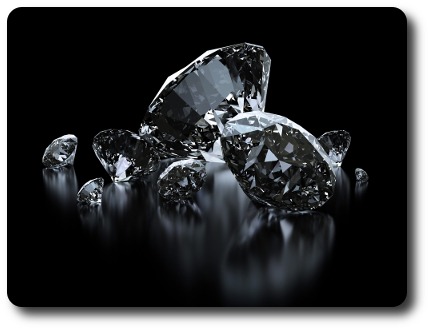
The term “well made” is often used by jewelry associates to describe the cut of the diamond.
What does it really mean?
The Federal Trade Commission says that you cannot say that a diamond is well made “if it is lopsided, or so thick or so thin in-depth as materially to detract from the brilliance of the stone.”
It all comes down to the cutting of the diamond.
Cutting is the only characteristic of a diamond that is completely under human control.
The cut is also the most important factor to emphasize when you are working with a client because all other factors being equal – the cut makes the diamond beautiful.
How a diamond reflects and plays with light helps a client understand why the cut is so important.
To an untrained eye,
every diamond sparkles
The more experienced your eye becomes, the more aware you are of the differences in quality between poorly cut and properly cut diamonds.
The cut reveals itself through the brilliance, fire, and scintillation of the finished diamond.
Diamond-Cut Terminology
Brilliance.
Brilliance is the total effect of light reflected and refracted from the interior and exterior surfaces of the diamond.
Refraction refers to the bending of light.
Fire.
Fire, also called dispersion, is the breaking up of white light into the colors of the spectrum.
Fire causes the “rainbow” effect that you see.
Scintillation.
Scintillation is the sparkle – the flashing effect seen when a diamond moves in the light.
To be a “well made” diamond there are several factors that the cutter must take into account.
The trade-off usually comes down between more diamond weight or more brilliance.
Diamonds are frequently cut for weight retention rather than to produce maximum brilliance.
For example,
An ideal round cut
diamond will measure
6.4 to 6.5 millimeters
in diameter
Most one carat diamonds on the market today measure between 5.9 and 6.3 millimeters because they were cut for weight.
These slimmer diamonds are cut deep to retain more weight thus the light goes out the side of the diamond instead of back through the crown.
To measure and analyze the various aspects of diamond proportions the GIA and other gemological laboratories use the Sarin Proportion Analyzer.
It measures the length, width and height, depth percentage, table percentage, girdle thickness, culet size, crown angle, crown height, pavilion angle, pavilion height, and diamond symmetry.
The pinnacle of a well
made diamond is
the “Tolkowsky Ideal”
The GIA (Gemological Institute of America) and the AGS (American Gemological Society) have similar views.
The AGS, however; takes a stricter, more narrow view than the GIA.
GIA.
The table percentage for a class 1 round cut diamond is 53% – 60%, crown angle of 34 – 35 degrees, medium to slightly thick girdle, 43% pavilion depth %, none to medium culet, and very good – excellent finish.
AGS.
The table percentage for an ideal cut AGS Zero is 52.4% to 57.5% table, 59% to 63% depth, crown angle of 33.7 to 35.8 degrees, thin to medium girdle thickness, 42.2% to 43.8% pavilion depth %, none to medium culet, excellent polish, and excellent symmetry.
The AGS also takes it a step further with a pavilion angle of 40.5 to 41 degrees, a length to width ratio of one to one, fluorescence of none to faint, and a crown height of 15% to 16.2%.
Whether a round cut diamond is well made or achieves the lofty ideal standards, it will have a degree of brilliance, fire, and scintillation that sets it clearly apart from all other round diamonds.
It is important to convey to your client the degree of craftsmanship and planning that goes into fashioning a well-made diamond.
Our “Inside the Jewelry Trade” Radio Show Episodes
The host of “Inside the Jewelry Trade” Radio Show – Jewelry Business Strategist – President of Four Grainer LLC. Author of the business books “A Reason To Chant,” and “A Reason to Chant – Jewelry Trade Edition.” Rod lives in Atlanta with his wife and two almost-human cats.